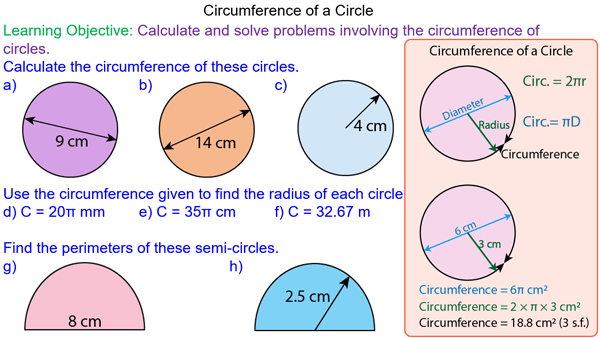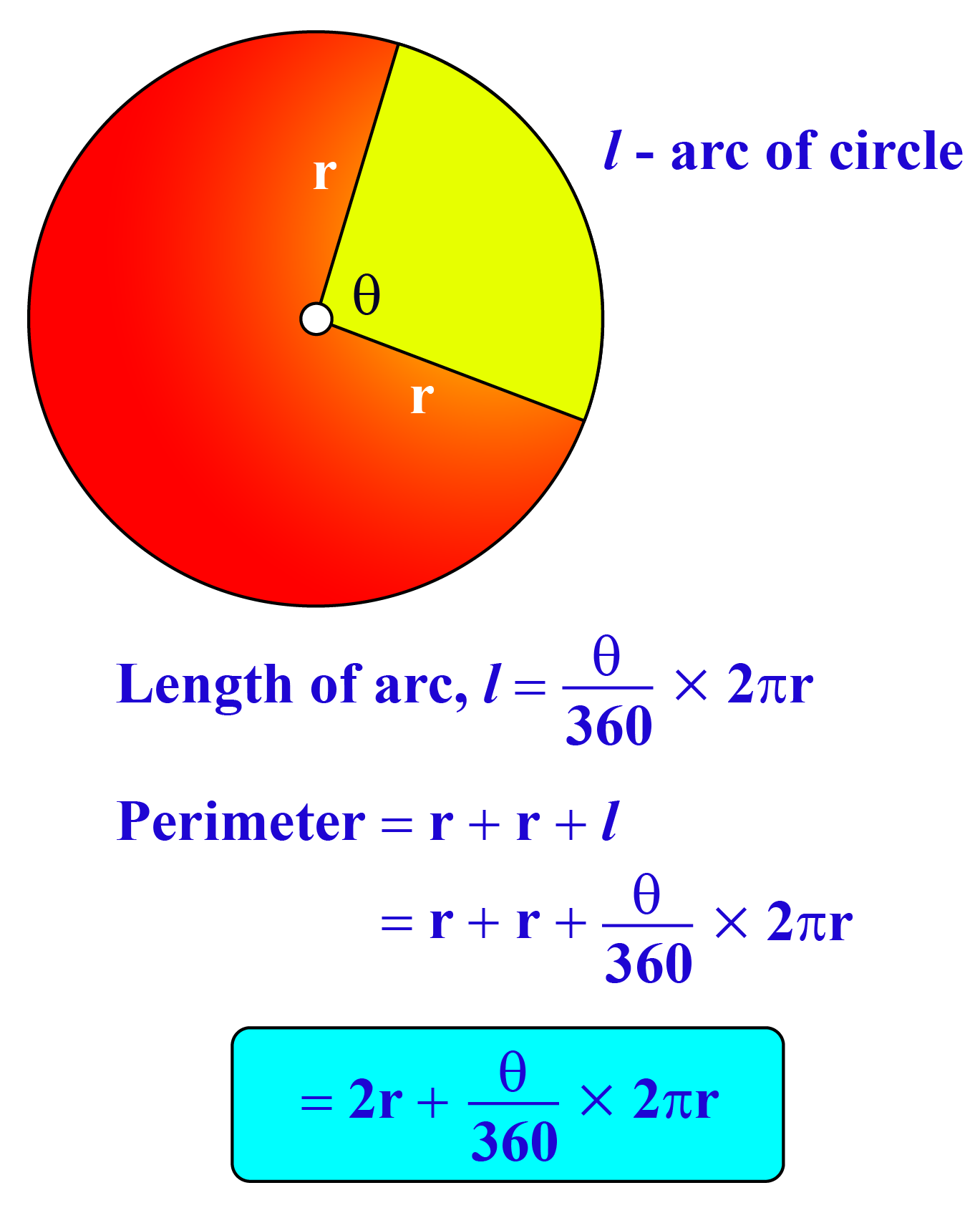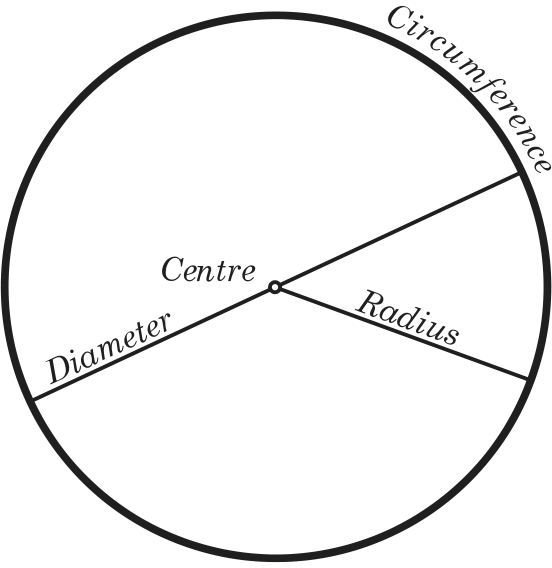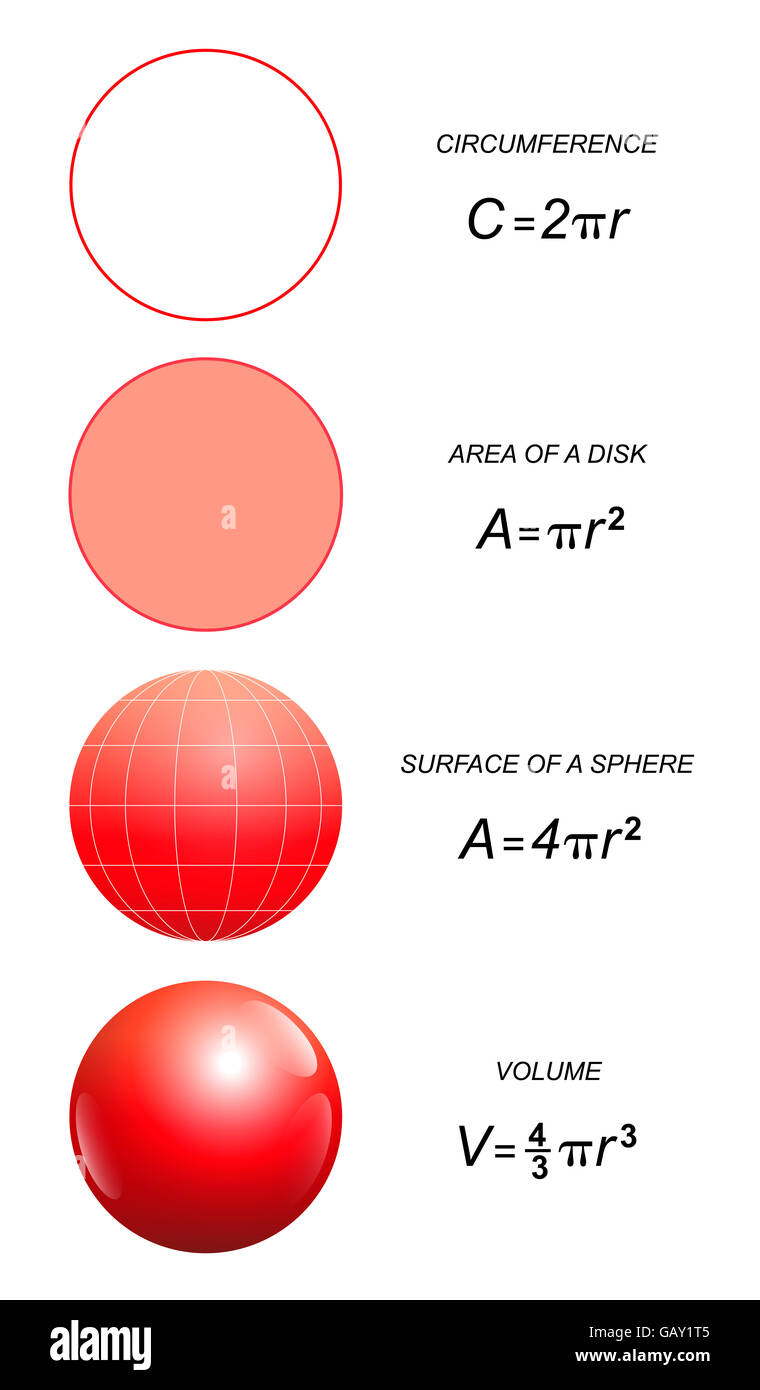As with triangles and rectangles, we can attempt to derive formulas for the area and "perimeter" of a circle. Calculating the circumference of a circle is not as easy as calculating the perimeter of a rectangle or triangle, however. Such a process is illustrated below. The circumference of a circle is the measurement around a circle's edge. It can be compared to finding the perimeter of a shape .
If you were to cut a circle and lay the outline flat, the length of the line it created would be its circumference. The circumference can be measured in any unit or system that traditionally measures length - imperial (inches, feet, etc.) or metric (centimeters, meters, etc.). Whichever unit the radius is measured in will also be the unit the circumference is calculated in.
The circumference of a circle of radius $r$ is $2\pi r$. This well known formula is taken up here from the point of view of similarity. It is important to note in this task that the definition of $\pi$ already involves the circumference of a circle, a particular circle. In order to show that the ratio of circumference to diameter does not depend on the size of the circle, a similarity argument is required. Two different approaches are provided, one using the fact that all circles are similar and a second using similar triangles.
This former approach is simpler but the latter has the advantage of leading into an argument for calculating the area of a circle. We'll teach you the key circumference formulas you need to figure out the circumference of a circle when you know either the diameter or radius. The formula for calculating the circumference of a circle from the diameter of a circle is very easy. Simply multiply the diameter by the number 3.14, which is also called the number pi (π).
The answer will be in the units of length by which the diameter is measured. In above program, we first take radius of circle as input from user and store it in variable radius. Then we calculate the circumference of circle using above mentioned formulae and print it on screen using cout.
The formula for the circumference of a circle in terms of its radius comes from the definition of the constant . The constant is defined as the ratio of any circles circumference divided by its diameter. This is illustrated in the figure below. The first solution requires a general understanding of similarity of shapes while the second requires knowledge of similarity specific to triangles.
The radius, the diameter, and the circumference are the three defining aspects of every circle. Given the radius or diameter and pi you can calculate the circumference. The diameter is the distance from one side of the circle to the other at its widest points. The diameter will always pass through the center of the circle.
The radius is half of this distance. You can also think of the radius as the distance between the center of the circle and its edge. Does calculating circumference have you running in circles? Our circumference calculator is an easy way for you to find the circumference of any circular object. Life is full of circles (and semi-circles). Therefore, the equation of the circumference of a circle can be useful in solving any problem involving circles.
Since circumference is a measurement of length, there are generally two main kinds of problems that will involve calculating the circumference of something circular. First, knowing the circumference of a circle can be used to create something circular. Second, if the circle is moving at a known speed, then the circumference can be used to determine how far the circle might travel in a given time. Two formulas are used to find circumference, C, depending on the given information.
Both circumference formulas use the irrational number Pi, which is symbolized with the Greek letter, π. Pi is a mathematical constant and it is also the ratio of the circumference of a circle to the diameter. It looks like you calculated the area of a circle using a radius of 2; in this figure, the radius of each circle is 1. To find the area of the figure, imagine the two semi-circles are put together to create one circle. Then calculate the area of the circle and add it to the area of the square. Thus, we can calculate the circumference of a circle if we know the circle's radius .
For most calculations that require a decimal answer, estimating π as 3.14 is often sufficient. For instance, if a circle has a radius of 3 meters, then its circumference C is the following. To make sure you are measuring the diameter correctly, it should be the biggest measurement you can get. If by moving the measurement instrument slightly you get a bigger diameter size, then go with that. As stated before, the perimeter or circumference of a circle is the distance around a circle or any circular shape. The circumference of a circle is the same as the length of a straight line folded or bent to make the circle.
The circumference of a circle is measured in meters, kilometers, yards, inches, etc. Suppose you know that the circumference of a circle is 20 centimeters and you want to calculate the radius. Just plug the value for the circumference into the equation and solve.
Remember that pi is approximately equal to 3.14. Lauren is planning her trip to London, and she wants to take a ride on the famous ferris wheel called the London Eye. While researching facts about the giant ferris wheel, she learns that the radius of the circle measures approximately 68 meters. What is the approximate circumference of the ferris wheel?
Use 3.14 as an approximation for pi. Once again in this example, we're given the radius of the circle. Although it's not a clean number like our previous example, but we can still simply plug the number directly into the formula like what we did above. Be aware of the units that this circle's radius is given in and remember to give your final answer in the same unit.
In this question, we find that the circumference is equalled to 53.41m. The distance from the centre to the outer line of the circle is called a radius. It is the most important quantity of the circle based on which formulas for the area and circumference of the circle are derived.
Twice the radius of a circle is called the diameter of the circle. The diameter cuts the circle into two equal parts, which is called a semi-circle. The distance around a rectangle or a square is as you might remember called the perimeter. The distance around a circle on the other hand is called the circumference . Perimeter of other shapes like squares. You can think of it as the line that defines the shape.
For shapes made of straight edges this line is called theperimeter but for circles this defining line is called the circumference. The diameter of the circle is the largest chord and is passing through the center of the circle. The circumference of the circle is the length of the outer boundary of the circle. Both the diameter and the circumference are lengths and have linear units for measurement. Also, the circumference of the circle is equal to the product of the diameter and the constant pi. Pi is a constant value used for the measurement of the area and circumference of a circle or other circular figures.
The symbol of pi is π and its numeric value is equal to 22/7 or 3.14. Further, these numeric values are used based on the context of the equation. Although the circumference of a circle is its length, it cannot be calculated with the help of a ruler like it is usually done for other polygons. This is because a circle is a curved figure. Therefore, to calculate the circumference of a circle, we apply a formula that uses the radius or the diameter of the circle and the value of Pi (π).
Circumference Of A Circle Formula Using Radius To calculate area and circumference we must know the radius of circle. The program will prompt user to enter the radius and based on the input it would calculate the values. To make it simpler we have taken standard PI value as 3.14 in the program.
Other details are mentioned as comments in the below example program. Now that you know how to calculate the circumference and area of a circle, you can use this knowledge to find the perimeter and area of composite figures. If you know the circumference, radius, or diameter of a circle, you can also find its area. Area represents the space enclosed within a circle.
It's given in units of distance squared, such as cm2 or m2. Write the formula for circumference of circle with radius r. Learn the circumference equation and definition. See examples of how to calculate circumference when given the diameter or radius. For example, the length of a 180 degree arc must be half the circumference of the circle, the product of pi and the radius. The length of any arc is equal to whatever fraction of a full rotation the arc spans multiplied by the circumference of the circle.
A 45 degree arc, for example, spans one-eighth of a full rotation, and is therefore equal to one-eighth the circumference of that circle. The length of an arc of n degrees equals (n/360) times the circumference. Try the free Mathway calculator and problem solver below to practice various math topics. Try the given examples, or type in your own problem and check your answer with the step-by-step explanations. Worksheetto calculate circumference of circle when given diameter or radius.
This lesson has provided you with lots of information the circumference of circles and a way to find any the measure of any one part if you have another measurement. Along the way, you also learned a little geography and history, which may also come in handy to you. The distance around a polygon, such as a square or a rectangle, is called the perimeter . On the other hand, the distance around a circle is referred to as the circumference . Therefore, the circumference of a circle is the linear distance of an edge of the circle.
This first argument is an example of MP7, Look For and Make Use of Structure. The key to this argument is identifying that all circles are similar and then applying the meaning of similarity to the circumference. The second argument exemplifies MP8, Look For and Express Regularity in Repeated Reasoning.
Here the key is to compare the circle to a more familiar shape, the triangle. Pi (π) is a special mathematical constant; it is the ratio of circumference to diameter of any circle. When we use the formula to calculate the circumference of the circle, then the radius of the circle is taken into account. Hence, we need to know the value of the radius or the diameter to evaluate the perimeter of the circle.
Circumference of the circle or perimeter of the circle is the measurement of the boundary of the circle. Whereas the area of circle defines the region occupied by it. If we open a circle and make a straight line out of it, then its length is the circumference.
It is usually measured in units, such as cm or unit m. The perimeter of a circle is the same as the circumference of a circle. It is the total length of the outer boundary of the circle. The perimeter or circumference of a circle is the product of the constant pi and the diameter of the circle. It is a linear one-dimensional quantity and has units such as m, inch, cms, feet. If you are given the radius of a circle instead of its diameter, it is easy to calculate the circumference .
Multiply the radius by 2, and then multiply by π. You can check this relationship of circumference to diameter by putting a piece of string around circular objects of different sizes, such as cans, coins, and plates. Measure the string against a ruler, yard stick, or meter stick to find the circumference.
Make a table like the one shown below, showing the diameter and circumference of each object you measure. This constant ratio of circumference to diameter is represented by the Greek letter π and is approximately equal to 3.14 or \(\frac\). The Greek letter p (pronounced as "pie") is used to describe this number. It stands for the ratio between the circumference of any circle and its diameter, and it's true for all circles. This means that any circle's circumference will be about 3.14 times the length of its diameter. It looks like you calculated the area of the square, but not the circle.
Imagine the two semi-circles are put together to create one circle. Thus, a circle is simply the set of all points equidistant from a center point . The distance r from the center of the circle to the circle itself is called the radius; twice the radius is called the diameter. The radius and diameter are illustrated below.


























